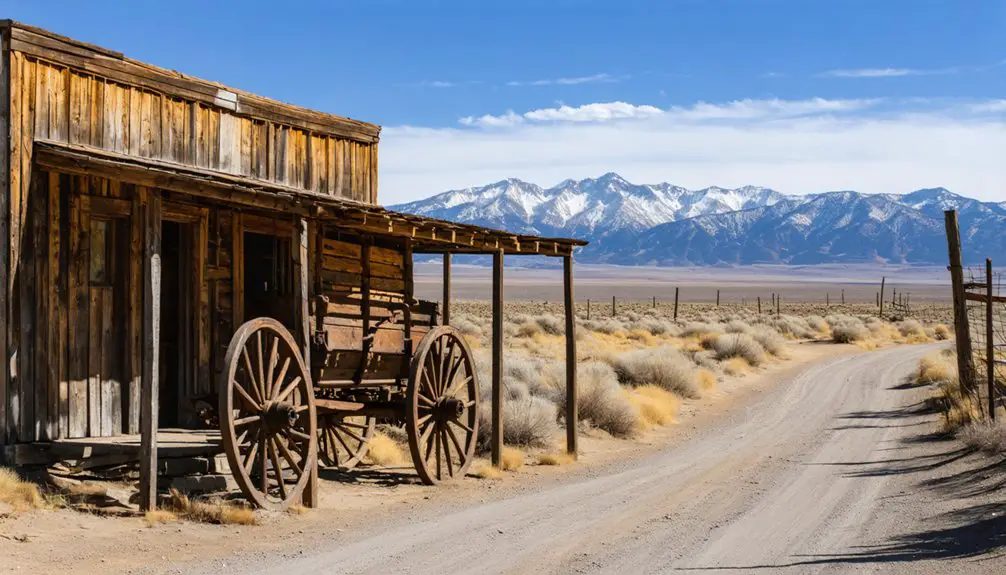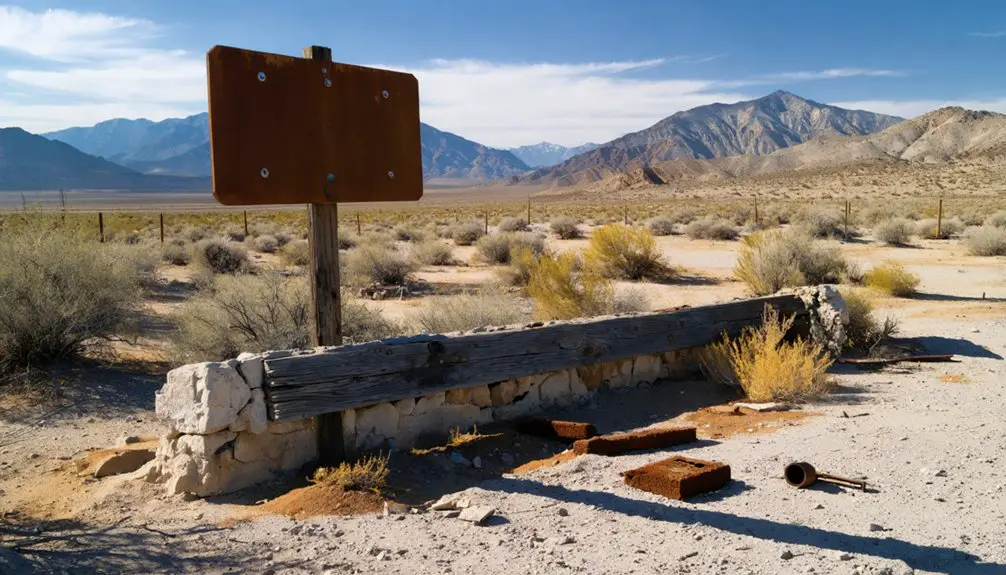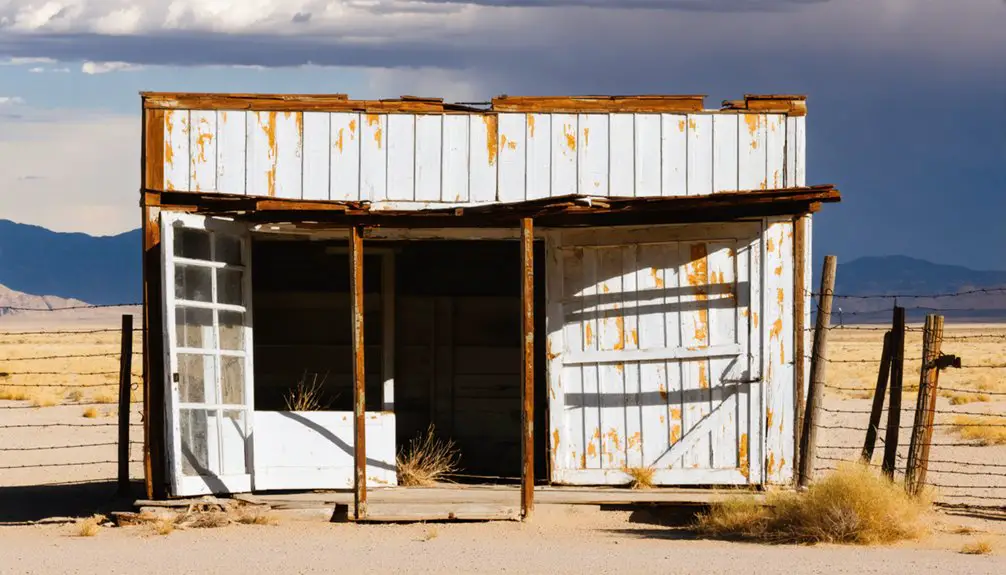You’ll discover Hiko, Nevada’s ghost town nestled in Pahranagat Valley, where Native Americans first guided prospectors to silver deposits in 1865. As Lincoln County’s first seat, Hiko flourished briefly under William Raymond’s ambitious $900,000 mining investment, complete with a five-stamp mill. However, poor silver returns, high operational costs, and the loss of county seat status to Pioche in 1871 led to its decline. The town’s remnants and historical markers tell a fascinating tale of frontier boom-and-bust.
Key Takeaways
- Hiko was Lincoln County’s first county seat in 1867 before declining when the seat moved to Pioche in 1871.
- William Raymond invested $900,000 in mining infrastructure, but poor silver returns of only $150,000 led to the town’s economic failure.
- The removal of the five-stamp mill to Bullionville in 1870 marked a critical turning point in Hiko’s decline toward ghost town status.
- Today, minimal structures remain from the 1860s mining era, with Nevada Historical Marker No. 206 commemorating the site’s history.
- The town struggled with lawlessness, including cattle rustlers and gunfights, contributing to its eventual abandonment as a mining settlement.
The Birth of a Silver Mining Settlement
When local Native Americans guided prospectors to silver deposits in the Pahranagat Valley in March 1865, they sparked the birth of what would become Hiko, Nevada. The name itself, initially spelled “Hyko,” came from a Native American term meaning “white man’s town.” Hiko’s abundant water springs helped attract the first permanent settlers to the area.
This pioneer settlement quickly attracted hundreds of fortune seekers after news of the silver discovery reached Austin, Nevada. In March 1867, Hiko’s growing importance was cemented when it became the Lincoln County seat.
William Raymond emerged as the driving force behind Hiko’s development in early 1866. After purchasing multiple mining claims, he laid out the townsite and transported a five-stamp mill via the Colorado River to Callville.
The mill, hauled by oxen across the rugged terrain, began crushing ore in November 1866, marking Hiko’s transformation from a prospector’s camp into a legitimate mining settlement.
Life in Early Pahranagat Valley
Before European settlers arrived in Pahranagat Valley, the Southern Paiute and Western Shoshone peoples thrived in this fertile landscape for thousands of years, developing sophisticated hunting, gathering, and small-scale farming practices.
You’ll find evidence of their rich cultural heritage in the valley’s protected rock art sites and sacred ceremonial grounds.
When pioneering families began settling in the mid-1800s, they encountered a complex social landscape. The valley had become notorious for harboring outlaws who’d stolen livestock from distant states. Over 350 different brands of stolen livestock were documented in the region during this period.
Yet settlers persevered, building stone homes like the Walden house and establishing ranches near essential springs.
Cultural adaptations emerged as both indigenous peoples and settlers navigated their changing environment – the natives maintaining camps near tree groves while settlers cleared land for grazing and farming, forever transforming the valley’s character.
Raymond’s Mining Legacy and Downfall
You’ll find William Raymond’s grand ambitions for Hiko reflected in his massive $900,000 investment in mining infrastructure, including a five-stamp mill hauled 140 miles by oxen in 1866.
Despite establishing the town as Lincoln County’s first seat and constructing extensive mining operations, Raymond’s venture yielded only $150,000 in silver returns against his substantial investment.
The venture’s failure ultimately led to the mill being relocated to Bullionville in 1870.
Investment and Initial Promise
After discovering silver deposits in the Pahranagat Valley in 1865, W. H. Raymond launched ambitious investment strategies to establish Hiko as a thriving mining hub.
You’ll find that by March 1867, he’d poured nearly $900,000 into the region, focusing on essential infrastructure like roads, dwellings, and mining operations.
Raymond’s crowning achievement was acquiring a five-stamp mill, which he transported via the Colorado River to Callville and then hauled 140 miles by oxen to Hiko.
When milling began in November 1866, the town’s prospects looked promising. The population swelled to several hundred, and Hiko secured its position as Lincoln County’s first county seat.
The name Hiko was derived from a Native American expression meaning “white man’s town.”
However, economic challenges soon emerged, as high freight costs and unskilled labor led to disappointing returns of only $150,000 on Raymond’s massive investment.
Costly Failure and Departure
Despite Raymond’s massive investment of $900,000 in Hiko’s development, his mining enterprise proved financially disastrous.
You’ll find that poor financial management and skyrocketing freight costs for hauling equipment 140 miles from Callville contributed heavily to the operation’s downfall. The venture yielded only $150,000 in returns, a devastating loss that couldn’t sustain the business.
Critical labor shortages and inexperienced workers crippled mining productivity, while competition from nearby districts drained potential resources. The mill’s eventual move to Bullionville in 1870 marked the final blow to Hiko’s prosperity.
From County Seat to Ghost Town
When silver was discovered in Nevada’s Pahranagat Valley in 1865, Hiko quickly transformed from an empty landscape into a bustling mining camp and administrative center.
The name Hiko itself, meaning “white man’s town” in the native Indian language, reflected the settlement’s rapid transformation. Despite W.H. Raymond’s massive $900,000 investment, the town’s decline began shortly after its peak. High freight costs and unskilled labor limited mining profits to just $150,000.
The loss of Hiko’s county seat status to Pioche in 1871 dealt the final blow. Without its administrative importance and following the removal of the five-stamp mill to Bullionville in 1870, the town’s population dwindled rapidly.
The proposed Eureka & Colorado Railroad might’ve saved Hiko, but those plans never materialized.
Today, you’ll discover only a small agricultural community of about 100 residents where a once-promising boomtown stood.
Transportation Challenges in the Nevada Frontier

Transportation limitations played a major role in Hiko’s fate, mirroring the broader challenges faced throughout Nevada’s frontier.
You’ll find that before railroads, the town relied heavily on stagecoach and wagon roads, which were often in deplorable condition. The harsh desert environment and mountainous terrain created significant environmental barriers that made travel treacherous and unpredictable. Early Native American trails provided the foundation for many of these transportation routes.
Private toll roads attempted to maintain essential passages, but Hiko’s isolation proved overwhelming. The town’s transportation infrastructure suffered from seasonal weather that rendered roads impassable, while poor maintenance further complicated mail and passenger travel. The Overland Mail Company operated stagecoaches that made the cross-country journey in 25 days, connecting distant settlements to coastal cities.
Despite toll roads aiming to keep routes viable, Hiko’s isolation deepened as weather and neglect made travel nearly impossible.
When railroads began expanding across Nevada in the late 19th century, connecting over 70 lines to mining towns, Hiko remained disconnected from these critical arteries of commerce. This isolation ultimately contributed to the town’s decline and eventual abandonment.
Lawlessness and Social Change
As silver discoveries in Pahranagat Valley attracted prospectors to Hiko in 1865, the region quickly descended into a period of intense lawlessness and social upheaval.
Without formal law enforcement, vigilante justice became the norm, leading to frequent gunfights and murders that filled Boot Hill Cemetery. Similar to nearby Pioche where 72 violent deaths occurred before the first natural death, the region was plagued by deadly confrontations.
Social conflict intensified as:
- Civil War sympathizers from both North and South clashed violently
- Native American raids and conflicts disrupted mining operations
- Cattle rustlers and horse thieves operated with impunity
The decline of mining by 1871 and Hiko’s loss of county seat status to Pioche marked a pivotal moment.
While the shift to ranching reduced population density, the area’s reputation for lawlessness persisted.
Even notorious figures like Queho, Nevada’s first serial killer, found refuge in this untamed frontier, highlighting the enduring challenges of maintaining order.
Present-Day Remnants and Historical Markers

Today’s visitors to Hiko encounter sparse remnants of its tumultuous past.
You’ll find minimal structures from the 1860s era, with only foundations and the original townsite layout marking its historical significance. The town’s mining heritage lives on through Nevada Historical Marker No. 206, located 5 miles north of Crystal Springs on State Route 318.
At 3,869 feet elevation, you can explore the ghost town‘s desert terrain where W. H. Raymond’s $900,000 investment once flourished.
While the five-stamp mill that drove Hiko’s economy was relocated to Bullionville in 1870, the surrounding landscape still bears witness to extensive mining activities.
The marker commemorates Hiko’s brief reign as Lincoln County’s first county seat and its Shoshone-derived name meaning “white man’s town.”
Frequently Asked Questions
What Happened to William H. Raymond After the Mining Operation Failed?
You’ll find Raymond’s legacy becomes unclear after the mining aftermath, though records show he transported his mill to Bullionville in 1869-1870, suggesting he continued pursuing mining ventures elsewhere.
Are There Any Surviving Buildings From the Original 1860S Settlement?
Precious pioneer properties haven’t survived – you won’t find any original 1860s buildings standing today. Limited historic architecture remains due to decades without preservation efforts and Hiko’s shift from mining to agriculture.
What Was the Average Silver Ore Grade in Hiko’s Mines?
You’ll find the silver extraction records show variable grades, from tens to hundreds of ounces per ton, with the richest mining techniques yielding up to $1,000 worth per ton in surface zones.
Did Any Notable Gunfights or Crimes Occur During Hiko’s Lawless Period?
While thousands of outlaws roamed Nevada, you won’t find documented gunfights or major crimes specifically in Hiko’s lawless era. Nearby Pioche saw violence, but Hiko’s short boom ended peacefully.
How Did Local Native American Tribes Interact With the Early Settlers?
You’ll find that Native Americans initially guided settlers to silver deposits, establishing cultural exchange and trade relations, though these cooperative beginnings eventually gave way to displacement and marginalization of indigenous peoples.
References
- https://www.destination4x4.com/hiko-lincoln-county-nevada-ghost-town/
- https://www.nvexpeditions.com/lincoln/hiko.php
- https://shpo.nv.gov/nevadas-historical-markers/historical-markers/hiko
- https://www.ghosttowns.com/states/nv/hiko.htm
- https://westernmininghistory.com/towns/nevada/hiko/
- https://ronhess.info/docs/report7_history.pdf
- https://westernmininghistory.com/gallery/538500/historical/mines/
- https://shpo.nv.gov/nevadas-historical-markers/historical-markers/pahranagat-valley
- https://npshistory.com/brochures/nwr/pahranagat-2009.pdf
- https://shpo.nv.gov/uploads/documents/Flip_Book_Magazine_with_links_reduced_file_size.pdf



